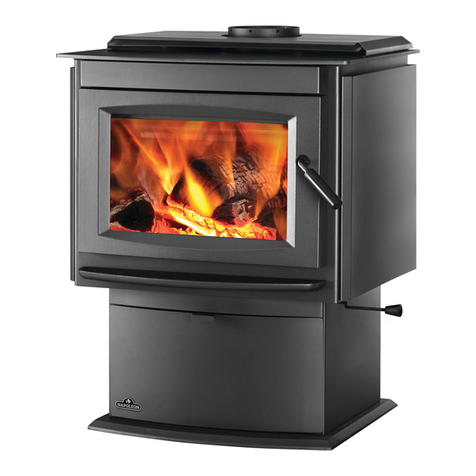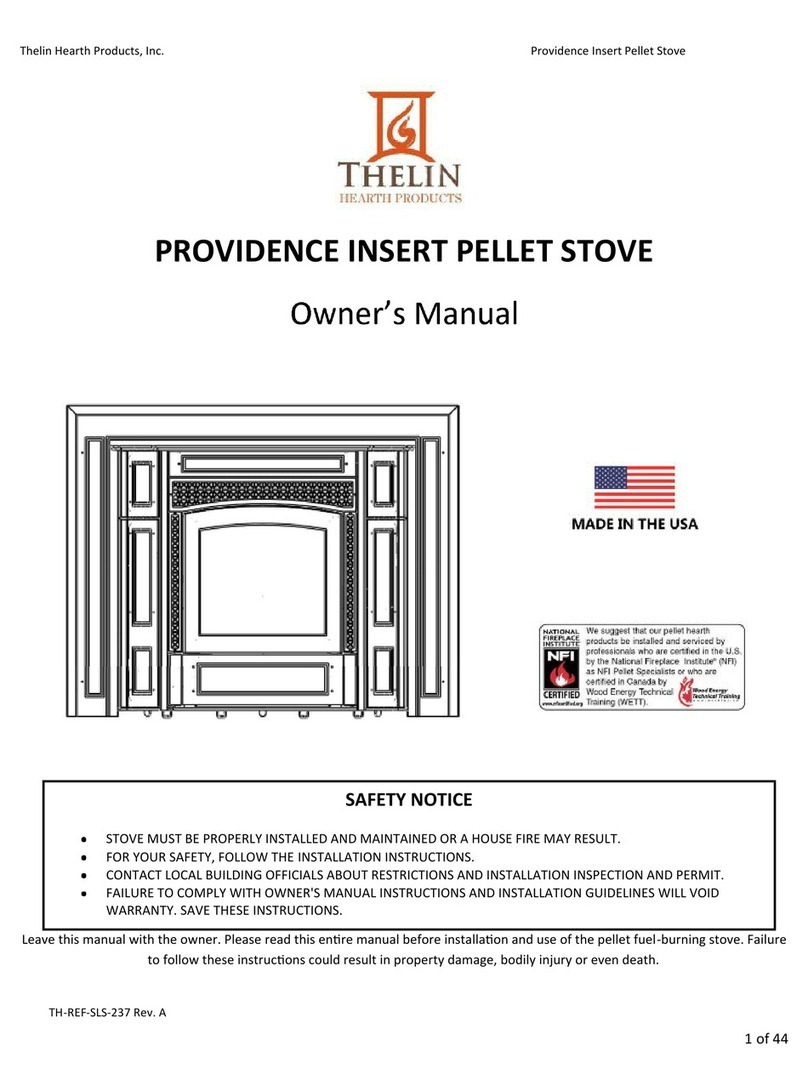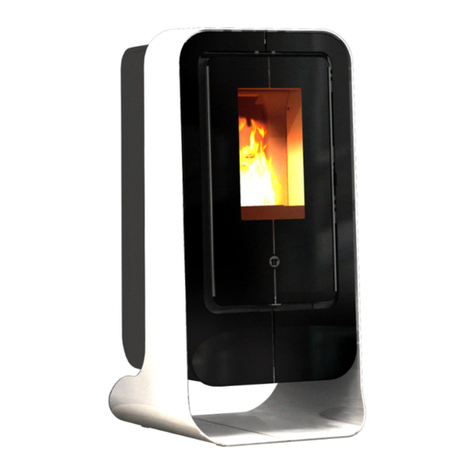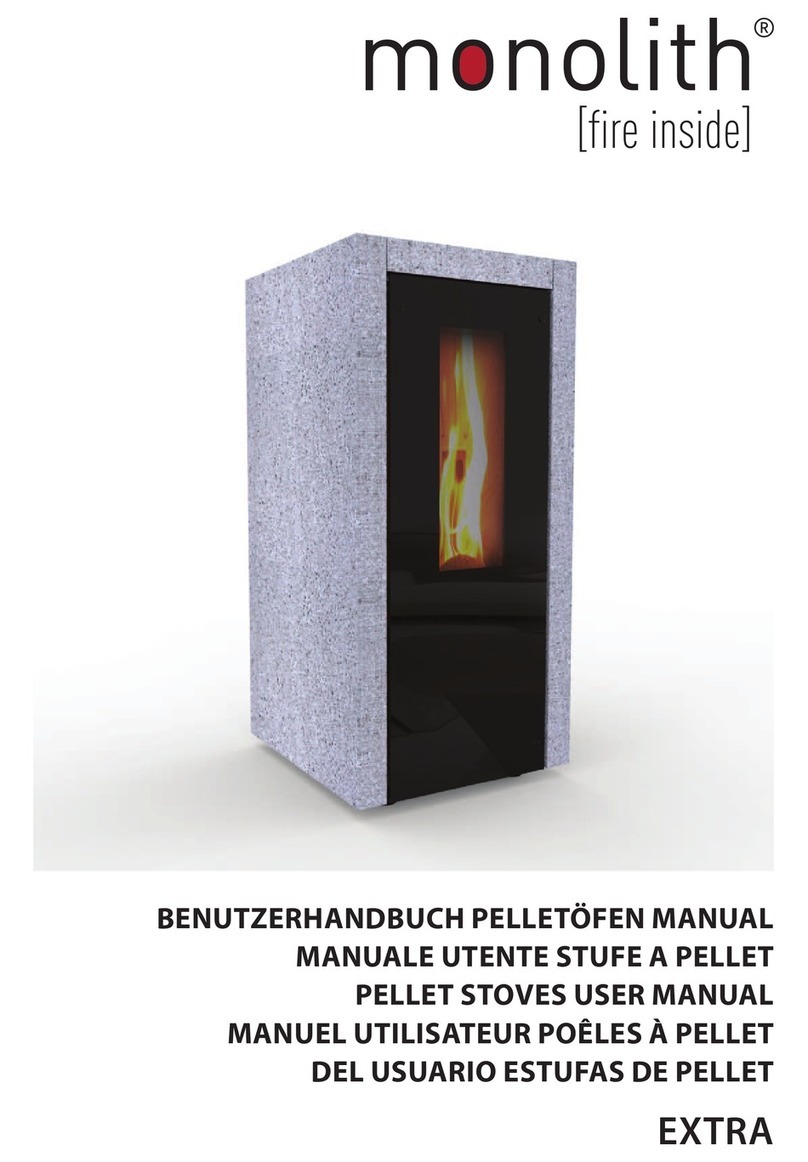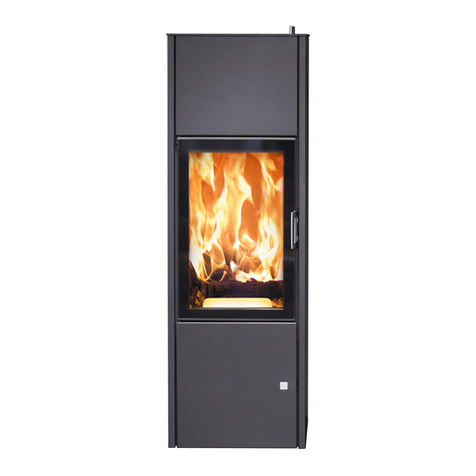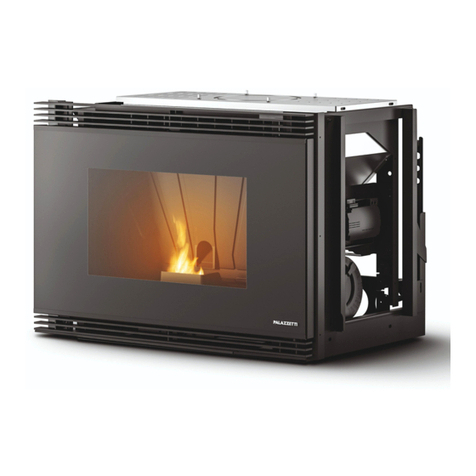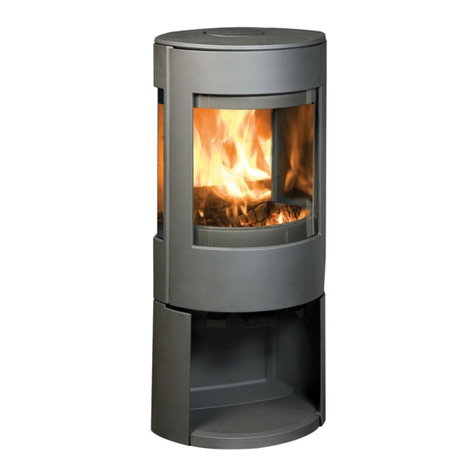PSG PHENIX User manual

45139A
OWNER`S MANUAL
OIL BURNING STOVE
PHENIX
Vérified and tested following
CAN/CSA B140.3 et UL 896 standards by:
Manufactured by:
SBI
1700 Léon-Harmel
Québec, (Québec)
G1N 4R9
www.psg-distribution.com
tel : (418 ) 527-3060
Fax : (418 ) 527-4311
READ THESE INSTRUCTIONS AND SAVE FOR REFERENCE

Page 1 of 15
TABLE OF CONTENT
READ THESE INSTRUCTIONS AND SAVE FOR REFERENCE.................................1
TABLE OF CONTENT ..................................................................................................1
INSTALLATION INSTRUCTIONS.................................................................................3
LOCATING THE STOVE...............................................................................................3
CHIMNEY INFORMATIONS .........................................................................................4
CONNECTING THE STOVE TO THE CHIMNEY..........................................................5
LEVELING THE UNIT...................................................................................................6
FIXATION OF STOVE TO FLOOR ...............................................................................6
CONNECTING STOVE TO OIL TANK..........................................................................7
ADJUSTING THE DRAUGHT.......................................................................................8
OPERATION INSTRUCTIONS .....................................................................................9
COMBUSTIBLE ............................................................................................................9
LIGHTING .....................................................................................................................9
CHANGING INTENSITY .............................................................................................10
TURNING THE STOVE OFF.......................................................................................11
MAINTENANCE..........................................................................................................11
TROUBLESHOOTING GUIDE....................................................................................12
CAUSES......................................................................................................................12
TROUBLESHOOTING GUIDE (CONT’D)...................................................................13
CAUSES......................................................................................................................13
SPARE PARTS...........................................................................................................14
PSG LIMITED LIFETIME WARRANTY.......................................................................15
REGISTER YOU WARRANTY ONLINE
To receive full warranty coverage, you will need
to show evidence of the date you purchased your
stove. Keep your sales invoice. We also
recommend that you register your warranty online
at
www.psg-distribution.com
Registering your warranty online will help us track
rapidly the information we need on your stove.

Page 2 of 15
TECHNICAL DATA
PHENIX OIL BURNING STOVE
COMBUSTIBLE : OIL NO1 OIL NO2
HEAT INPUT : Kw BTU/h Kw BTU/h
Minimum: 5,9 20 450 4,8 16 600
Maximum: 10,9 37 250 9,6 33 150
FLOWRATE : cc/min litres/h cc/min litres/h
Minimum: 9,9 0,60 7,5 0,45
maximun: 17,3 1,04 16,1 0,97
MINIMUM DRAUGHT REQUIRED : 0,06 INWC 0,06 INWC
EFFICIENCY : % %
with fan : 78,5 79
without fan : 77 77
CLEARANCES TO COMBUSTIBLES
Mm in
Back 255 10
Side 305 12
Corner 255 10
A MINIMUM CLEARANCE OF 9’’ (230 mm)
FROM SINGLE WALL FLUE PIPE TO
COMBUSTIBLES MUST BE ALLOWED.
DIMENSIONS
mm in
Height : 889 35
Width : 508 20
Depth : 572 22½
Ø outlet flue pipe : 130 5
Ø burner : 255 10

Page 3 of 15
INSTALLATION INSTRUCTIONS
LOCATING THE STOVE
• Install the stove as close to the chimney as possible.
• Many configurations are possible, the most frequent are illustrated in figures 1, 2 and 3.
• Respect clearances indicated on page 1. They have been tested according to approvals.
• Always respect clearances of stove pipes manufacturers. Larger clearances always prevail.
Figure 1 : CORNER INSTALLATION
Figure 2 : PARALLEL INSTALLATION
Figure 3 : WALL INSTALLATION
Table 1 : CLEARANCES TO COMBUSTIBLES
mm in
Back 255 10
Side 305 12
Corner 255 10
Flue Pipe 230 9
• IMPORTANT: It is essential to ensure that the room where the stove is located is sufficiently
ventilated to provide an adequate air supply.
• If your home is well insulated, it is possible that you will have to install an outside fresh air intake.
THE BURNING OF ONE LITRE OF FUEL (OIL) REQUIRES APPROXIMATELY 30 M3OF AIR AND
WILL PRODUCE ABOUT 0.8 KG OF WATER OF WATER VAPOR AND 9 M3OF CARBONE
DIOXIDE AND ATMOSPHERIC NITROGEN. A SOURCE OF AIR FROM THE OUTSIDE IS NEEDED
TO REPLACE COMBUSTION AIR.

Page 4 of 15
CHIMNEY INFORMATIONS
• Before the hook up of the stove, check if the chimney is in good condition and that the quality of
the flue pipe will allow a sufficient draught. For a good combustion, refer to the technical data of
the stove to know the minimum draught required.
• Factory built ‘’A’’ type chimney or ‘’L’’ type chimney are approved for this unit. The chimney has to
be well insulated. A chimney too cold can affect the gas temperature and lower draught effects.
Low gas temperature will tend to condense and freeze or leak in your chimney.
• 5" factory built chimney is required. Using a larger flue tends to expand combustion gas and cools
them off witch has for result of lowering the draught effects. Gas expansion reduces the speed of
the draught and have the same effects.
• When the unit is installed on a masonry chimney which is often oversize, it’s required to use a
stainless steel liner of 5" diameter inside the existing chimney.
• The chimney has to reach a minimum of 15' high (including stove pipes). The chimney has to
extend not less than 3' above the point it exits the roof and 2' higher than any roof, building other
obstacle within a horizontal distance of 10'.
• CHIMNEY MINMUM HEIGHT :
Height of chimney should not be inferior
than 15’ (4.6 m).
Figure 4: CHIMNEY MINMUM HEIGHT
• CLEARANCES WITH ROOF SUMMIT AND
BUILDING NEARBY :
The chimney flue shall extend at least 2’ (0,6
m) above the highest roof surface or
structure within 10’ (3,0 m) horizontally of
the chimney.
Figure 5: CHIMNEY CLEARANCES
• CLEARANCE FROM ROOFING INTERSECTION :
The chimney flue shall extend at least 3’ (0,9 m) above the highest point at witch it comes in
contact with the roof.
YOUR APPLIANCE SHALL BE CONNECTED TO CHIMNEY HAVING SUFFICIENT
DRAUGHT AT ALL TIMES TO ASSURE SAFE AND PROPER OPERATION OF THE
BURNER.

Page 5 of 15
CONNECTING THE STOVE TO THE CHIMNEY
• The gases are vented from the back of the unit. The female part of the black pipe connector has to
be installed toward the flue connector of the stove. Secure all connections with the (3) self taping
screws, with 120odistance between each of them.
• The connection between stove pipes and chimney has to be perfectly sealed.
• A maximum horizontal length of 8' is allowed. Make sure to have a 1/4" slope per foot minimum.
• Do not use more than two 90oElbows while connecting the stove to the chimney.
• It is strictly forbidden to pass through combustible materials walls, floors and ceilings with stove
pipe connectors.
• DIRECT HORIZONTAL CONNECTION :
You may choose to connect your stove to
the chimney with an horizontal flue pipe.
Figure 6: HORIZONTAL CONNECTION .
• CEILING CONNECTION :
In the case where your chimney starts from
the ceiling, use one 90º elbow and the
necessary straight sections.
Figure 7: CEILING CONNECTION .
• DO NOT CONNECT MORE THAN ONE
STOVE TO YOUR CHIMNEY.
• FIX FLUE PIPES TOGETHER WITH
METAL SCREWS.
• MAKE SURE YOU RESPECT A ¼’’ SLOPE
PER FOOT OF HORIZONTAL PIPE
LENGTH.
• RESPECT CAREFULLY CLEARANCES TO
COMBUSTIBLES PRESCRIBED BY FLUE
PIPES MANUFACTURERS.
• FLUE PIPES CLEARANCES TO
COMBUSTIBLES DEPEND ON FLUE
PIPES TYPE AND MANUFACTURERS
• VERTICAL CONNECTION :
It is recommended to not use more than two
(2) 90º elbows and the necessary straight
sections to connect your stove to the
chimney.
Figure 8: VERTICAL CONNECTION .

Page 6 of 15
LEVELING THE UNIT
• Now that the stove is in place and properly
hooked up to the chimney, you have to adjust
the level on the burner.
• Put the level in the middle of the burner
parallel to the door. (Figure 9A). Screw or
unscrew the adjustable legs to level the
burner with a 7/16" key (10 mm).
• Put the level in the middle of the burner
parallel to the sides. (Figure 9B). Screw or
unscrew the adjustable legs to level the
burner with a 7/16" key.
Figure 9A: LEVELLING THE BURNER
IMPORTANT :
IT IS VERY IMPORTANT TO LEVEL THE
BURNER TO ALLOW A PROPER OIL VAPOR
DISTRIBUTION THROUGH THE RINGS, AND A
BETTER OIL INLET.
Figure 9B: LEVELLING THE BURNER
FIXATION OF STOVE TO FLOOR
• The unit has to be stabilized in its location
using the two fixation brackets. Install the
brackets on the two back adjustable legs.
(figure 11)
• If the flooring is made of combustible
material it would be preferable to install the
unit on an non combustible surface covering
at least the dimensions of the stove.
Figure 10: INSTALLATION OF FIXATION
BRACKETS

Page 7 of 15
CONNECTING STOVE TO OIL TANK
• Make sure that the tank outlet is 12" (305 mm) higher than the inlet of the carburetor. (Gravity fed)
• Use only copper piping to connect tank to stove.
• Make sure that there is a small slope on the connection from the tank toward the stove.
• A 3" (75 mm) down slope is needed on the tank itself, from the outlet towards the other end of the
tank.
• When the tank is installed outdoors, it is preferable to use oil #1, to avoid viscosity problems.
NOTE : THE BAROMETRIC TANK SHALL BE LOCATED SO THAT THE TANK WILL NOT BE
EXPOSED TO THE DIRECT RAYS OF THE SUN OR BE ADJACENT TO ANY SOURCE
OF INTENSE HEAT.
Figure 11 : STOVE AND OIL TANK CONNECTION

Page 8 of 15
ADJUSTING THE DRAUGHT
• Your stove operated with natural draught, created by the ascension of combustion gases in the
chimney. This movement creates a siphon effect in the stove and forces ambient air to go in the
burner by the holes in its surround. These orifices let air in for combustion.
• For the unit to function properly, it is essential to check the quality of the draught using a draught
gauge. The draught is usually measured in inches of water column.
• Check the minimum draught required of the unit on page 1. The draught mentioned has to be
reached rapidly at a minimum settling (position #1).
• Depending on the model, the draught can be taken by the orifice on left side of the stove.
IMPORTANT : ALWAYS MEASURE THE DRAUGHT WITH ALL VENTILATION EQUIPMENT
INSTALLED IN THE HOUSE (RANGE HOOD, BATHROOM FAN, AIR EXCHANGER, DRYER, ETC
IN OPERATION.) ref. : standard CAN/CSA B-139 art. 4.1.5.
DRAUGHT REGULATOR
• An excessive draught is as bad as a draught
to low.
• The regulator controls the draught when it is
excessive (in high winds for exempla).
• If the draught exceeds 0.08 in of water
column, you will have to adjust the regulator.
• To adjust the draught you have to screw or
unscrew the court weight on the regulator.
Regulator open lowers the draught regulator
closed increases the draught.
Figure 12: DRAUGHT REGULATOR
THE ONLY RIGHT WAY OF MEASURING THE DRAUGHT IS TO USE A DRAUGHT GAUGE THAT
GIVES A READING IN INCHES OF WATER COLUMN. ALL OTHER METHOD (CANDLE,
MATCHES, ETC.) ARE UNRELIABLE.
INSTALLATION OF YOUR STOVE HAS TO BE IN ACCORDANCE WITH CAN/CSA B-139
INSTALLATION CODE FOR OIL-BURNING EQUIPMENT IN CANADA AND STANDARD NFPA 31
NATIONAL FIRE PROTECTION ASSOCIATION STANDARD FOR OIL-BURNING EQUIPMENT IN
THE U.S..
THE INSTALLATION SHALL BE MADE BY A QUALIFIED PERSON MEMBER OF THE
CORPORATION IN FORCE IN YOUR AREA.

Page 9 of 15
OPERATION INSTRUCTIONS
COMBUSTIBLE
• Your stove has been designed to work with oil #1 or #2. DO NOT USE GASOLINE, CRANKCASE
OIL OR ANY OIL CONTAINING GASOLINE. The manufacturer declines all responsibility regarding
damage cause by using other combustibles.
• Make sure to use oil without impurities which may plug filters and valve’s orifice. Impurities only
give an improper combustion.
LIGHTING
BEFORE LIGHTING
• make sure that :
The tank is full;
The isolating valve is open;
• See that the (2) rings are in the right
position. Each of them are stamped A and B
(figure 13).
• Make sure that the flow regulating handle is
in the « 0 » position (figure 14b).
• If it’s not already done, arm down the valve’s
lever located behind the stove (figure 14A).
• Wait for the valve to fill up and let the level
stabilize.
• BEFORE ATTEMPTING TO LIGHT YOUR
STOVE, MAKE SURE THAT THE FLOW
REGULATING HANDLE IS IN THE 0
POSITION.
Figure 14B: CONSTANT LEVEL FLOW
CONTROL VALVE (CARBURATOR)
Figure 13: RINGS POSITION
Figure 14B: ARMING / DEARMING FLOW
CONTROL VALVE (CARBURATOR).

Page 10 of 15
LIGHTING (CONT’D)
• Place the flow regulating handle on the "1" position, as soon as the oil enters the burner
return to "0" position.
• Open the door and pore into the burner 2 to 3 once (75 ml) of lighting gel or wood
alcohol.
NOTE : USE OF LIGHTING GEL IS BETTER FOR A SAFE IGNITION.
• With a long wood match, ignite carefully and close the door.
• After a couple of minutes (before alcohol goes out) the burner and the chimney are hot,
place the flow regulator handle on "1" position.
Note : Do not leave matches or other materials in the burner in order to
keep it clean. It allows a better combustion.
IF YOU MISS THE STOVE’S LIGHTING, ALWAYS WAIT FOR THE
BURNER TO COOL DOWN TO ROOM TEMPERATURE BEFORE
USING BURNING ALCOHOL AGAIN.
IF, FURTHER TO SOME MISOPERATION, THE BURNER IS FILLED
WITH IMPORTANT QUANTITIES OF OIL, ALL OF THE OIL MUST
FIRST BE REMOVED BEFORE LIGHTING THE STOVE AGAIN.
CHANGING INTENSITY
• Always wait 10 minutes minimum before increasing the flow (between each position). This allows
flame to stabilize and avoid suiting up.
• No waiting is needed to decrease the flow.

Page 11 of 15
TURNING THE STOVE OFF
• Set the flow regulating handle to position ‘’0’’.
• If you plan to keep the stove off for a long while, it is recommended to disarm the valve’s lever and
close the tap on the pipe between the stove and your oil tank.
ALWAYS KEEP THE VALVE SHUT OFF WHEN THE BURNER IS NOT OPERATING
MAINTENANCE
ONCE A WEEK :
• Clean the oil inlet tube of the burner with the
cleaning tee :
Push in the rod of the cleaning tee while
turning it;
Move back and forth operation 2 or 3
times;
Pull it back into place to finish the
operation.
Figure 15 : CLEANING TEE
WHEN YOUR STOVE IS RUNNING, ALWAYS KEEP THE CLEANING TEE LEVER PULLED BACK
INTO PLACE.
ONCE A MONTH OR TWO :
• Clean with a metallic brush :
• The burner’s shell;
• The burner’s rings;
• The burner’s catalyst (in blue flame model).
AT THE BEGINNING OF EACH HEATING SEASON :
• Clean the valve and tank filters;
• Inspect the smoke box through the opening of the rear flue outlet;
• Clean the chimney and flue pipe.
MAKE SURE THAT ALL HAND VALVES ARE CLOSED BEFORE CLEANING PROCEDURES.
WHEN NEEDED :
• Clean the glass door.
• The glasses have to be cleaned only when the stove is cold. Use commercial product for this
purpose, or a water and vinegar solution.

Page 12 of 15
TROUBLESHOOTING GUIDE
PROBLEMS
CAUSES
SOLUTION
ON POSITION 6 (MAXIMUM)
THE FLAME IS LONG AND
SMOKY, THERE IS SUIT
BUILD UPON THE GLASS.
Position 6 was reached too
quickly.
1. Set flow regulating handle
to position 1;
2. wait for combustion to
stabilize;
3. Progressively increase flow
to desired position.
NOTE : SEE LIGHTING
PROCEDURES.
Maximum flow is too high. 1. Set flow to a lower position;
2. Call a qualified technician
to adjust the valve.
ON POSITION 1 (MINIMUM)
THE FLAME PRODUCES
SMOKE AND SUITS THE
GLASS.
Cleaning tee and/or burner are
dirty. 1. Activate cleaning tee
according to procedures;
2. Schedule at the next shut
off to clean the burner.
Orifice of plunger is partially
plugged. 1. Progressively increase flow
to position ‘’6’’;
2. Push in many consecutive
times on the thermostatic
regulator bottom to remove
dirt form the orifice.
NOTE : If the problem persist,
you may have to remove and
clean out the valve with alcohol.
Call your specialized
technician.
ON POSITION 1 (MINIMUM)
THE FLAME PRODUCES
SMOKE AND SUITS THE
GLASS.
Flow is to low. 1. Slightly increase the flow
regulating handle;
2. Call a specialized
technician.

Page 13 of 15
TROUBLESHOOTING GUIDE (CONT’D)
PROBLEMS
CAUSES
SOLUTION
THE FLAME PRODUCES
SMOKE, IN ANY POSITION. Door gasket is not selling
properly. 1. Tighten door by turning
counter-clockwise the door
handle;
2. Check if gasket needs to be
changed.
The burner orifices are plugged
up. 1. Clean the burner with a
metallic brush.
Draught is too low. 1. Make it checked by a
technician.
FLAME GOES OUT BY
ITSELF. Oil level in the tank is too low.
1. Fill up the tank.
Air pocket is stocked in the oil
line. 1. Call a technician to drain the
line;
2. Make sure that the oil line
has an adequate slope
towards the tank.
Oil #2 is used in exterior tank. 1. Use only oil #1 when tank is
installed outside.
Partial or total obstruction by
impurities in oil line or filters. 1. Check filters on tank and
valve;
2. Ask a technician if the
cleanness of the tank and
line is OK.
THE STOVE MAKES NOISE,
GOES OUT AND LIGHTS UP
AGAIN.
The stove has been lit while
excess of oil was in the burner. 1. Position the flow regulating
handle to ‘’0’’;
2. Let the stove cool down;
3. Clean the burner if
necessary.
Note : Never light the stove
when the burner is full of oil.
Sponge the oil out before
lighting.

Page 14 of 15
SPARE PARTS
After years of use, if you need to replace some parts, please contact your SUPPLIER or one of our PSG
approved DEALERS.
• Give him product data as displayed in your warranty voucher or on your appliance’s name plate at
the rear. Keep the warranty voucher even after its EXPIRY date.
• Our dealers are in possession of all spare parts nomenclatures and technical data about our
products, and will provide you with the spare parts you need and any maintenance intervention
within the scope of their professional competence.

Page 15 of 15
PSG LIMITED LIFETIME WARRANTY
The warranty of the manufacturer extends only to the original consumer purchaser and is not transferable. This warranty
covers brand new products only, which have not been altered, modified nor repaired since shipment from factory. Proof
of purchase (dated bill of sale), model name and serial number must be supplied when making any warranty claim to
your PSG dealer.
This warranty applies to normal residential use only. Damages caused by misuse, abuse, improper installation,
lack of maintenance, over firing, negligence or accident during transportation are not covered by this warranty.
This warranty does not cover any scratch, corrosion, warping, or discoloration caused by over firing, abrasives or
chemical cleaners. Any defect or damage caused by the use of unauthorized parts or others than original parts void this
warranty. An authorized qualified technician must perform the installation in accordance with the instructions supplied
with this product and all local and national building codes. Any service call related to an improper installation is not
covered by this warranty.
The manufacturer may require that defective products be returned or that digital pictures be provided to support the
claim. Returned products are to be shipped prepaid to the manufacturer for investigation. If a product is found to be
defective, the manufacturer will repair or replace such defect and reasonable transportation fees will be refunded. Repair
work covered by the warranty, executed at the purchaser’s domicile by an authorized qualified technician requires the
prior approval of the manufacturer. Labour cost and repair work to the account of the manufacturer are based on
predetermined rate schedule and must not exceed the wholesale price of the replacement part. All labour and freight
costs covered by this warranty are limited according to the table below.
The manufacturer at its discretion may decide to repair or replace any part or unit after inspection and investigation of
the defect. The manufacturer may, at its discretion, fully discharge all obligations with respect to this warranty by
refunding the wholesale price of any warranted but defective parts The manufacturer shall in no event be responsible for
any special, indirect, consequential damages of any nature, which are in excess of the original purchase price of the
product.
WARRANTY APPLICATION
DESCRIPTION PARTS LABOUR
Combustion chamber (welds only) and castings Lifetime 5 years
Plating (defective manufacture) – subject to limitations above Lifetime n/a
Burn pot 5 years 3 years
Stainless steel baffle and parts 5 years 3 years
Carbon steel baffle and parts 2 years 1 year
Blowers, thermal switches, rheostat, carburator, and other
controls 2 years 1 year
Paint (peeling), gaskets, insulation, cast iron burner rings, and
ceramic glass (thermal breakage only*) 1 year n/a
*Pictures required
Shall your unit or a components be defective, contact immediately your PSG dealer. Prior to your call make
sure you have the following information necessary to your warranty claim treatment:
• Your name, address and telephone
number;
• Bill of sale and dealer’s name;
• Serial number and model name as indicated on
the nameplate fixed to the back of your unit;
• Nature of the defect and any relevant
information.
Before shipping your unit or defective component to our plant, you must obtain from your PSG dealer an
Authorization Number. Any merchandise shipped to our plant without authorization will be
refused automatically and returned to sender.
Table of contents
Popular Stove manuals by other brands
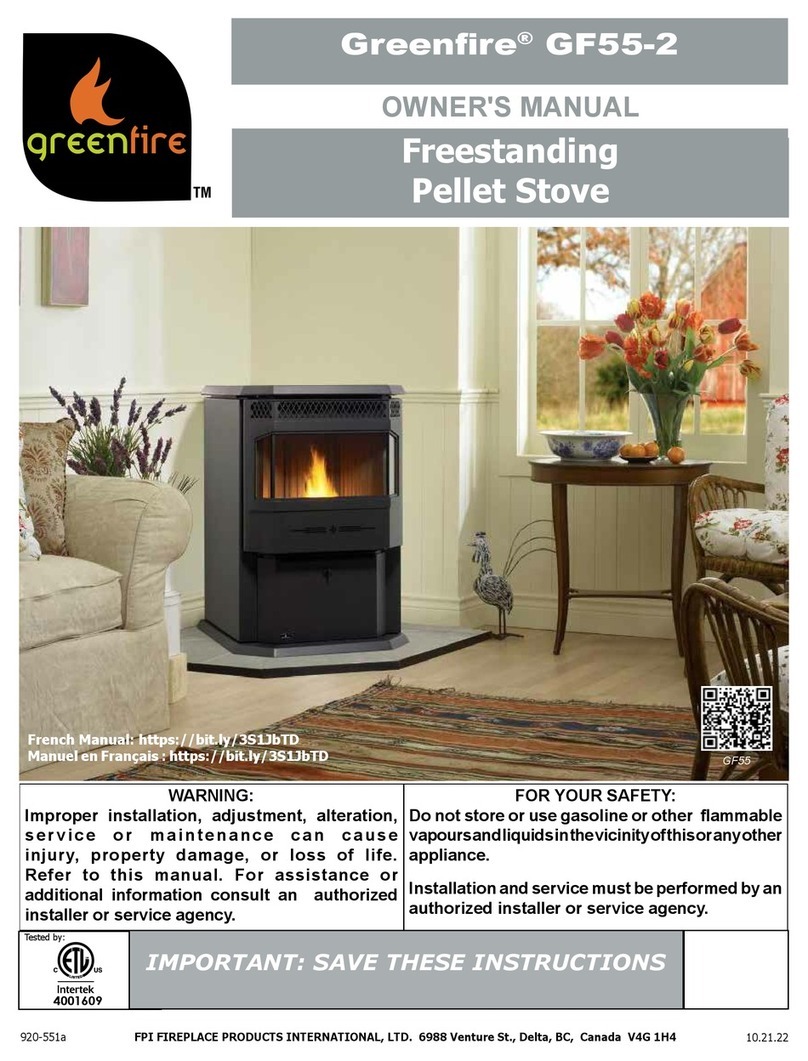
FPI
FPI Greenfire GF55-2 owner's manual
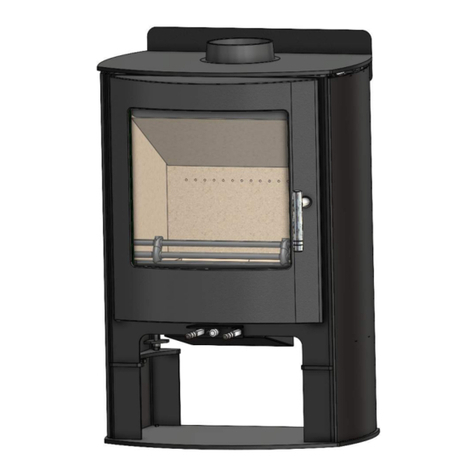
Mendip Stoves
Mendip Stoves Churchill 5 SE MK4 Dual Control Operation and installation manual

HWAM
HWAM Wood 3600 Range Installation and operation
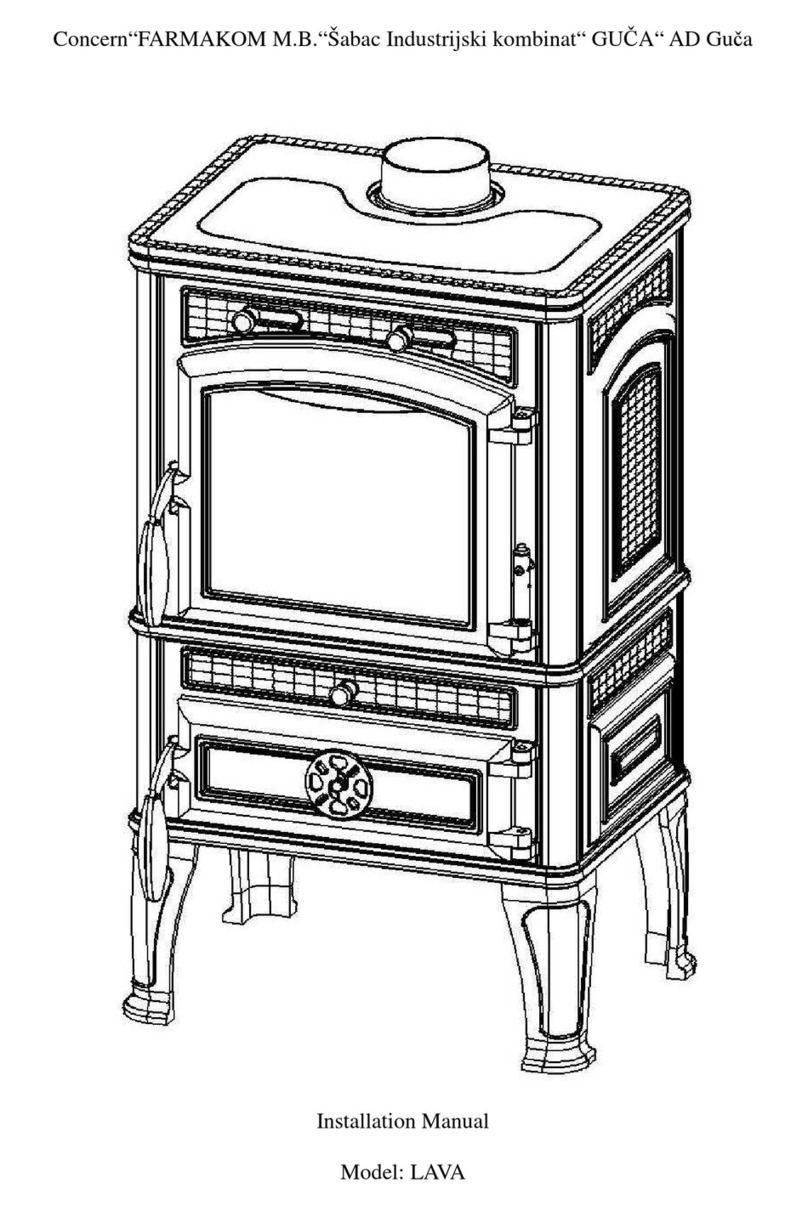
FARMAKOM M.B.
FARMAKOM M.B. LAVA installation manual

Capital
Capital SIRIUS TRADITIONAL Installation and operating instructions

Bronpi
Bronpi HUELVA instruction manual

